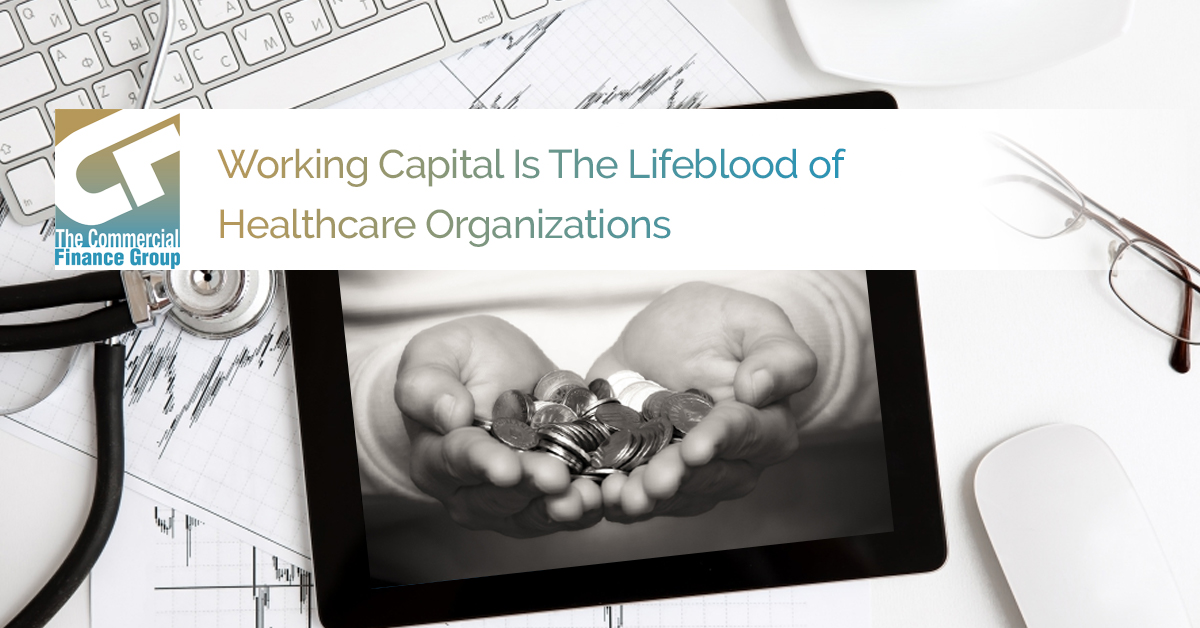The health food craze has really gained some traction in the past decade, and the American people seem to be slowly but surely becoming more health conscious. While working toward that next cycling race or keeping a close eye on those calories is no doubt important to your health, what about the financial health of a company?
At The Commercial Finance Group, we find that a lot of importance is placed on physical health, but the financial health of an organization is often put aside as a sort of “I’ll do that later” kind of thing. Strangely enough, one of the industries that seems to be experiencing poor financial health is healthcare organizations – specifically private doctor facilities, skilled nursing and staffing facilities, closed-door pharmacies, rehab centers, small hospitals, hospice care facilities, assisted living facilities, imaging centers, and more. Shouldn’t these places be free of working capital troubles? After all, we count on these healthcare organizations to keep us safe and healthy.
Today, our working capital solutions company is going to touch on the importance of healthcare receivables finance. If you work with a healthcare business that’s constricted by cash flow problems, The Commercial Finance Group can help! Our commercial lending services are specifically designed to improve our your cash flow so that you can focus on what’s important and what you do best: providing valuable, often life-saving services to patients. Let’s take a closer look at healthcare receivables finance.
In General, Working Capital Is Important
Working capital is a necessity for businesses, healthcare-related and otherwise. Why? Well, businesses require a regular amount of cash to make routine payments, cover unexpected costs, and purchase basic materials used in the production of goods. Think of working capital as an individual’s cost of living – people need to collect money they are owed and thus maintain a certain amount on a daily basis to cover day-to-day expenses, bills, and other regular expenditures.
So, what working capital represents is a prevalent metric for the efficiency, liquidity and overall health of a company. Working capital reflects the results of various company or organization activities, like revenue collection, debt management, inventory management and supplier payments. Think of working capital as a sort of financial health assessment.
The Problem That Healthcare Companies Are Experiencing
Due to various expansion measures and sweeping changes in the healthcare industry at large, many healthcare providers are finding that they have to wait longer periods of time in order to receive payments from patients and third party payers. As a result, these healthcare companies report a turnaround time of 45 to 90 days on their claims receivable, which translates to healthcare companies experiencing restricted growth of their business.
As a financial solution, most banks will provide a loan for the provider’s real estate or equipment. However, the borrower may actually find it more difficult to secure financing to help with the growth and to support the ongoing working capital needs of the company. What’s the answer to these issues? Receivables financing is the solution.
Working Capital Management In Action
An October 2012 study conducted by the Department of Health Systems Administration at Georgetown University, published in the US National Library of Medicine National Institutes of Health, looked at the importance of working capital management in the context of hospital profitability. Specifically, the study looked at the evidence of successful working capital management from bond-issuing, not-for-profit U.S. hospitals.
The main purpose of the study was to examine and understand the relationship between hospitals’ profitability and their performance at managing two components of working capital. The components consisted of accounts receivable, which was measured in terms of hospitals’ average collection periods, and accounts payable, which was measured in terms of hospitals’ average payment periods. The methodology was done using panel data derived from audited financial statements for 1,397 bond-issuing, not-for-profit U.S. hospitals in 2000-20007. The panel data was analyzed using a hospital-level fixed-effects regression analysis.
Implications of Working Capital Management In Hospitals
What the study found was a negative relationship between hospitals’ average collection period and profitability. In other words, hospitals that collected on their patient revenue faster reported significantly higher profit margins as compared to hospitals that have larger balances of accounts receivable outstanding, or unpaid invoices. The study also found a negative relationship between hospital’s average payment period and their profitability.
The main findings of this study suggested that successful, effective working capital management does, in fact, matter when it comes to hospitals’ profitability. Efforts aimed at reducing large balances in both accounts receivable and accounts payable financing are often worthwhile and sensible investments that have the potential to reduce the costs associated with working capital management and thus improve the profitability of a given healthcare organization.
We Can Help!
You guessed it – The Commercial Finance Group is here to provide your healthcare organization with accounts receivable financing and working capital solutions so that you don’t have to wait for patients and vendors to pay their invoices. Don’t let your healthcare organization fall into stagnation due to tied up cash flow issues. Contact us today for more information on how we can help your healthcare business!






